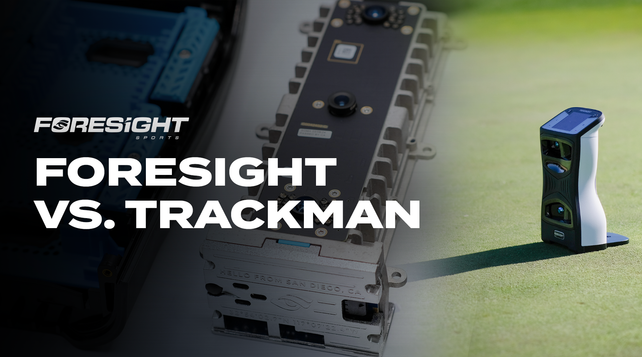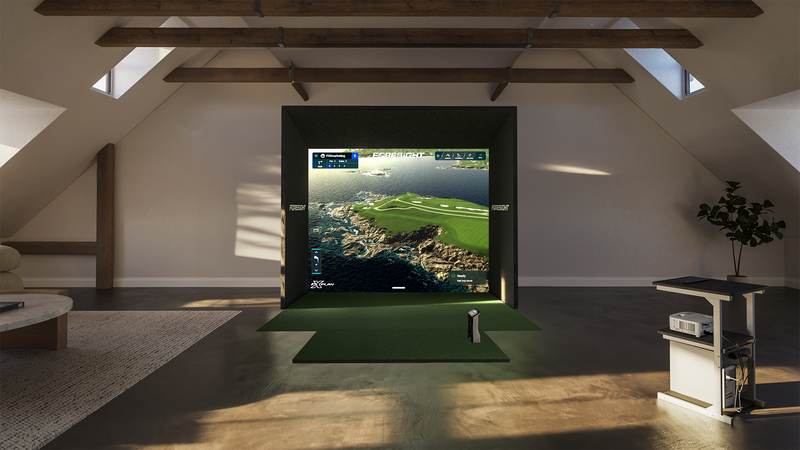Foresight Sports vs Trackman | Learning the Key Differences
Apr 29, 2025
Over the past decade-plus, golf launch monitor technology has evolved from a niche tool into a must-have resource for players, coaches and fitters at every level. As the demand for accurate, real-time feedback has grown, so has the number of companies vying for space in the market.
In today’s analytics and data-driven world, which shapes our lives on and off the golf course, there is no substitute for having the best possible information so you can make an informed decision.
We believe what you measure matters more than what you guess. While others rely on calculations and algorithms, we stick to direct measurement because that’s how golfers get data they can trust.
In this head-to-head comparison, we break down why our technology delivers more consistent, reliable and game-ready results, especially when it comes to the critical data points of clubface delivery and spin axis. Let’s get into it.
Understanding How Data is Captured
Measured vs. Calculated – What’s the Difference?
Not all data is created equal. There’s a critical difference between data that’s measured and data that’s derived or calculated.
At Foresight Sports, we measure what matters most – the moment of impact. Using ultra-high-speed cameras, our launch monitors capture true, real-time data on club delivery and ball behavior at the exact instant of collision. This measured impact data forms the foundation for everything else.
From there, we can derive downrange outcomes like carry distance, peak height and descent angle using physics-based models grounded in reality. In other words, the only assumptions we make are based on actual, observed events.
Trackman takes the opposite approach. Rather than measuring impact directly, it uses radar to track portions of ball flight, then calculates – or derives – club delivery and spin axis based on that limited data. The result is a model that starts with assumptions and builds additional layers of derivative data, rather than one grounded in verified measurement.
That’s the fundamental difference:
-
Foresight Sports measures impact to derive outcome.
-
Trackman derives impact based on outcome.
When it comes to clubface orientation, spin axis and other critical performance metrics, the difference between measured and derivative data matters – especially if you're relying on that information to improve your swing, fit a club or coach a player.
Tested by the Best | Spin Rate & Spin Axis Deviations

Trust and accuracy are everything.
To put our numbers to the test, we turned to Gene Parente, founder of Golf Laboratories and one of the most respected names in golf equipment testing. For over 35 years, Gene’s independent data and robotic testing protocols have shaped how the game’s biggest brands and governing bodies evaluate performance.
In his head-to-head comparison of the GCQuad and Trackman 4, Gene found something telling:
-
On center strikes, GCQuad delivered spin rates with less than half the standard deviation of Trackman – 82 vs. 175 RPMs, and a much tighter range (226 vs. 620 RPMs). See data in chart below.
-
On off-center strikes, both systems performed well – but GCQuad’s edge in spin rate consistency remained a key differentiator.
And that matters – a lot. As Gene puts it:
“Spin rates determine total distance. If the spin is wrong, so is the distance. It's like having a caddie who keeps giving you bad numbers.”
Spin axis data told another important story. On both center strikes and toe strikes, GCQuad delivered far more consistent spin axis data compared to Trackman 4 – while heel strike data was fairly comparable. See data in the charts below:
What That Means for You
The ability to measure spin axis and spin rates with consistency means players and coaches can trust every number they see – whether they're working on shaping shots or dialing in distances. Unlike radar-based systems that struggle with environmental factors or rely on calculated estimates, Foresight Sports measures reality in real-time – indoors, outdoors, on the range or in a studio.
Click here to read our in-depth story on Gene’s testing process and go deeper on the data. Want to see all the numbers? We’ve got nothing to hide, here are the full results of the GCQuad vs. Trackman 4 testing:
"The totality of the data shows inconsistencies in each competitor's product, but Foresight Sports products maintain their consistency throughout,” adds Parente. “Would you buy a dozen golf balls knowing that five of them weren't actually a Pro V1? That's a comparison I like to make after digesting the data."
Spin Axis & Clubface: The Real Test
Let’s get into specifics.
Foresight Sports:
-
Spin axis is directly measured at the moment the ball leaves the clubface. In plain terms: it’s the true curve of the ball, based solely on the interaction between club and ball – no wind, no assumptions.
-
Club data and ball data are captured separately. The system doesn’t rely on one to explain the other. This independence ensures unmatched accuracy, especially on mis-hits or off-center strikes.
-
Indoor or outdoor, it doesn’t matter. The way we measure doesn’t change with the setting – so the numbers stay consistent.
Trackman:
-
Outdoors, spin axis is calculated using ball speed, total spin and the curvature of flight. That might sound good on paper – until wind gets involved. Even a light breeze can corrupt the result.
-
Indoors, it’s all algorithms. Trackman uses estimated relationships between club path and face angle to guess spin axis – and can fail to account for the influence of off-center contact, which can massively impact spin.
-
Club and ball data are codependent, meaning inaccuracies in one area ripple through the rest of the data.
Why It Matters
When the data isn’t pure, neither is the feedback. And if your launch monitor can’t give you consistent, trustworthy results – especially in the key areas of clubface and spin axis – you’re practicing, coaching or fitting with misinformation.
Foresight Sports eliminates that uncertainty. We measure what matters – independently, accurately and in any environment.
Key Features Compared
Understanding the tech is what we do, but at the end of the day what really counts is how you use it and how it actually works in the real world. Here’s how Foresight Sports stacks up against Trackman when it comes to core features and usability.
Precision and Simplicity
Like we already discussed, our units use advanced camera-based technology to deliver direct measurements with unmatched accuracy – indoors or out. Every shot is captured without guesswork or reliance on external conditions. Here are few things that make our setup stand out:
-
Barometric readings built into the unit ensure distances stay accurate no matter the altitude, humidity, or temperature.
-
No wires. No apps. No nonsense. Turn it on, set it down, and start hitting. You don’t need a phone, tablet or computer to get started.
-
Ultra-portable and plug-and-play, which means instructors, coaches, and players can set up in seconds and trust the data right away.
This kind of usability creates a seamless and stress-free experience every time.
Trackman: Complex Setup, Conditional Accuracy
There’s no denying that Trackman is a powerful system, but it’s one that comes with some strings attached.
-
Radar needs space – which means indoor setups can get complicated or inconsistent depending on the environment.
-
Requires external devices to operate. You’ll need to connect to a phone or tablet just to get started.
-
Climate variability can impact accuracy – Trackman doesn’t include onboard barometric adjustments, so readings may shift depending on where and how you’re using it.
Trust Earned, Not Given
Foresight Sports doesn’t give our products to tour pros. They pay for them, and still choose us. That says everything.
When world-class players and respected testing experts align on one thing – GCQuad’s unmatched consistency and trustworthiness – that level of faith goes beyond the data. It reaffirms that purchasing a Foresight Sports launch monitor is a decision you can feel confident about.
Cost-Effectiveness & Value That Lasts
When it comes to launch monitor technology, price is certainly part of the equation. However, the real value lies in what you get for your investment – and what you’ll continue to get over time.
Out of the box, here’s a quick chart to give you a glimpse of competitive starting prices for both GCQuad, GC3 and Trackman.
Smarter Investment, Less Overhead
In addition to a more affordable initial cost, Foresight Sports delivers premium performance without locking you into costly subscriptions.
-
The GCQuad and GC3 come fully equipped out of the box – no hidden fees or required add-ons.
-
Only the GC3S, our entry-level unit tailored for more casual users, features a subscription tier.
In contrast, Trackman users are required to subscribe to access key features and maintain software functionality. That ongoing cost adds up, year after year.
Whether you're considering a GC3, GCQuad or a full simulator buildout, our pricing structure is straightforward. There are no surprise charges for upgrades or essential tools, and your investment stays relevant for years.
If we’re being honest, Foresight isn’t just the more cost-effective option – it’s the more trusted one. You’re saving money and making gains.
Radar-based systems may offer a slick pitch, but when you dig into the details, the advantages of Foresight Sports are undeniable:
-
True club and ball data – never inferred, never estimated
-
Consistent performance, whether indoors or out
-
Portable, intuitive hardware backed by the most trusted software in the industry
-
And lower long-term costs with no compromises in quality
For players, coaches and fitters who want complete confidence in their numbers, Foresight Sports is the clear choice. Because when every shot matters, the truth isn’t optional.











































